As we explore the intricacies of mastering Spot-Lock and Anchor Lock features on today's trolling motors, it's clear these technologies can revolutionize our fishing strategy. With the power of GPS keeping us steadily in place, despite unfavorable conditions, there's a whole new level of precision at our fingertips. While the seamless control sounds impressive, getting the most out of these features requires more than just the push of a button. The key lies in proper setup and maintenance—let's unravel the secrets that might just transform our experience on the water. Will we reveal its full potential?
Understanding Spot-Lock and Anchor Lock
Traversing the waters with precision, Spot-Lock and Anchor Lock offer anglers the technology to maintain their boat's position effortlessly. These systems transform our fishing experience by letting us focus on casting lines rather than controlling the boat.
Spot-Lock, for instance, uses GPS Accuracy to keep our boat within a small circle, about five feet from a chosen spot. It automatically adjusts the trolling motor's speed and direction, taking into account Environmental Factors like wind and waves. This guarantees we stay put, even in unpredictable conditions.
But how does this magic happen? By pressing the anchor button on the i-Pilot remote, we activate Spot-Lock's hands-free operation. With the i-Pilot's capability to save and quickly recall up to three different positions, anglers can efficiently switch between prime fishing spots with minimal effort. Its ability to maintain its position, even among strong currents, allows us to concentrate on catching that big fish we've been dreaming about.
On the other hand, Anchor Lock, similar in function to Spot-Lock, uses GPS to nail down our boat's position too. Both systems aim to make fishing as enjoyable and stress-free as possible. Whether we choose Spot-Lock or Anchor Lock, we've a reliable partner on our boating adventures, facing nature's challenges with ease and precision.
Key Benefits for Anglers
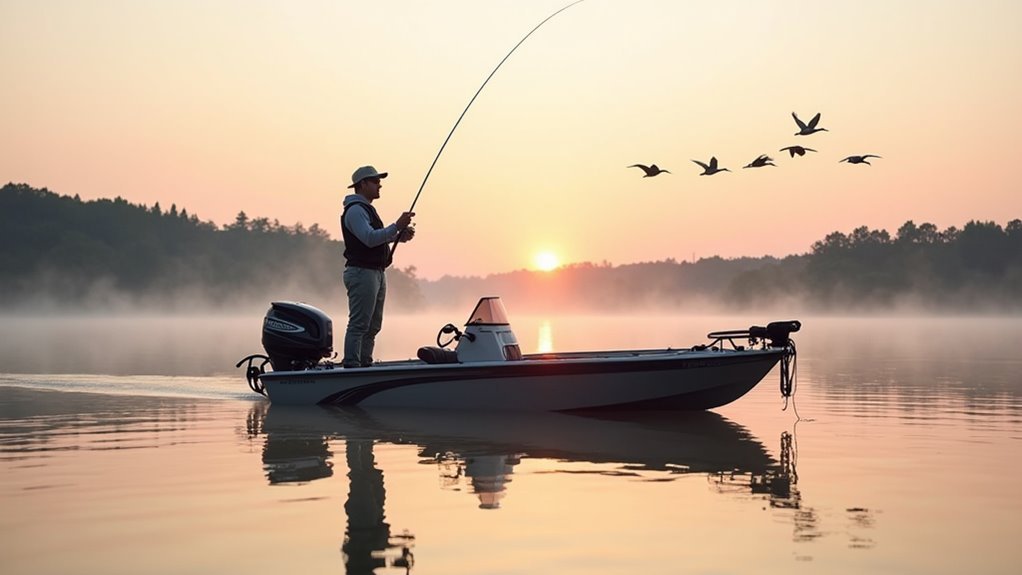
When we're out on the water, mastering the key benefits of Spot-Lock technology can substantially enhance our fishing experience. With its precise positioning, we can stay right over those hot fishing spots, maintaining within a narrow 3-6 feet range. It's like having an invisible anchor keeping us steady even when the wind or current tries to push us around. No longer do we need to battle with constant manual adjustments. Our fishing strategies can now focus on angler efficiency, allowing more time in that sweet strike zone rather than fidgeting with the boat.
Using GPS technology, Spot-Lock ensures that your boat remains anchored in place even under challenging weather and water conditions. Imagine drifting quietly without spooking the fish or exploring varied fishing methods with flexibility. Spot-Lock supports dynamic techniques such as casting or live baiting. It opens up a world of strategic fishing advantages by allowing us to focus on pattern fishing and structure fishing, thereby adapting to moving conditions. Let's embrace the freedom and efficiency Spot-Lock offers and make the most of every trip on the lake or ocean.
Equipment Compatibility
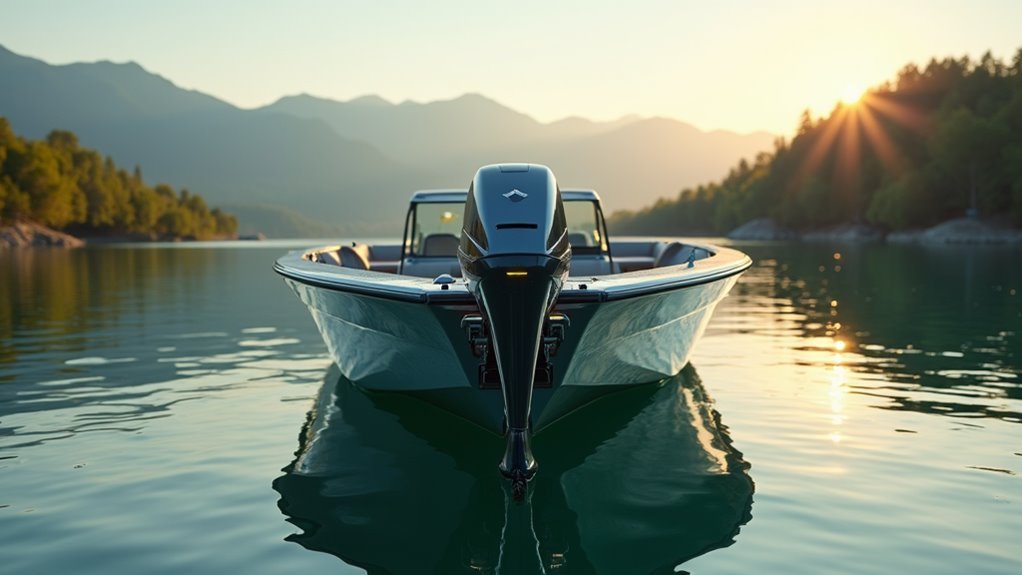
Compatibility is the cornerstone of a seamless fishing experience. When it comes to choosing the right trolling motor, our freedom on the water often depends on how well our equipment works together.
Let's talk about sonar integration and brand compatibility, as these are vital components that can elevate or limit our fishing adventures.
With so many options available, consider the following:
- Minn Kota: Easily integrates with Humminbird electronics and offers Universal Sonar 2, making it versatile across different sonar brands. Plus, their One Boat Network provides thorough control.
- Garmin: For the ultimate freedom, Garmin's full GPS capabilities require Garmin-specific sonar. It connects wirelessly with Garmin chartplotters, making it an appealing choice if you're already aboard the Garmin ecosystem.
- Lowrance: Known for its beautiful sonar imaging with its HDI sonar nosecone, Lowrance works seamlessly with its own fish finders and offers a customizable foot pedal to keep control at our fingertips.
- MotorGuide: It shines with its ability to mix and match with various sonar brands and has durable construction, essential for our long fishing expeditions. Ensuring that your trolling motor is equipped with quality batteries is crucial for maximizing time on the water, allowing you to take full advantage of its features.
Having the right equipment compatibility guarantees we're ready to seize every opportunity the water offers.
Setting Up Your Trolling Motor
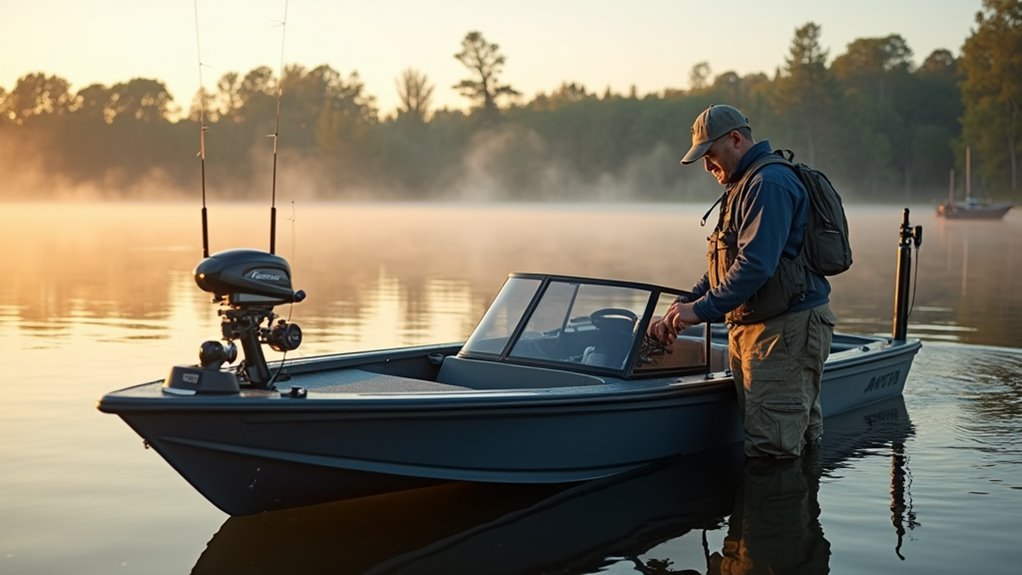
With our equipment ready to work in harmony, let's shift our attention to setting up the trolling motor effectively. Installing the trolling motor begins with Motor Alignment, essential for smooth operation. We must align the motor bracket with the mount on the boat deck, securing it with hand tools, and following any torque guidelines. A 3 mm hex bit or wrench comes in handy to attach the bracket firmly. Additionally, making sure the gas spring rotates clockwise for proper alignment is key to a stable setup. Spot Lock technology can significantly enhance fishing efficiency by maintaining the boat's position hands-free, even in strong winds or currents.
Now, let's talk about Cable Management—an important part of our adventure. We need to route the power cable carefully to the breaker panel. Should the cable be too short, extending it with the right wire gauge and secure connections, using solder and heat-shrink, guarantees safety and efficiency. Make sure our connections lead to a 60 A circuit breaker, not yet powered on. Additional cables, like the transducer, will run to the chartplotter port. Remember, installing cable clips not only helps secure the cables but also keeps our deck looking tidy and free from tripping hazards.
Proper setup now means more freedom to explore later.
Best Practices for Usage
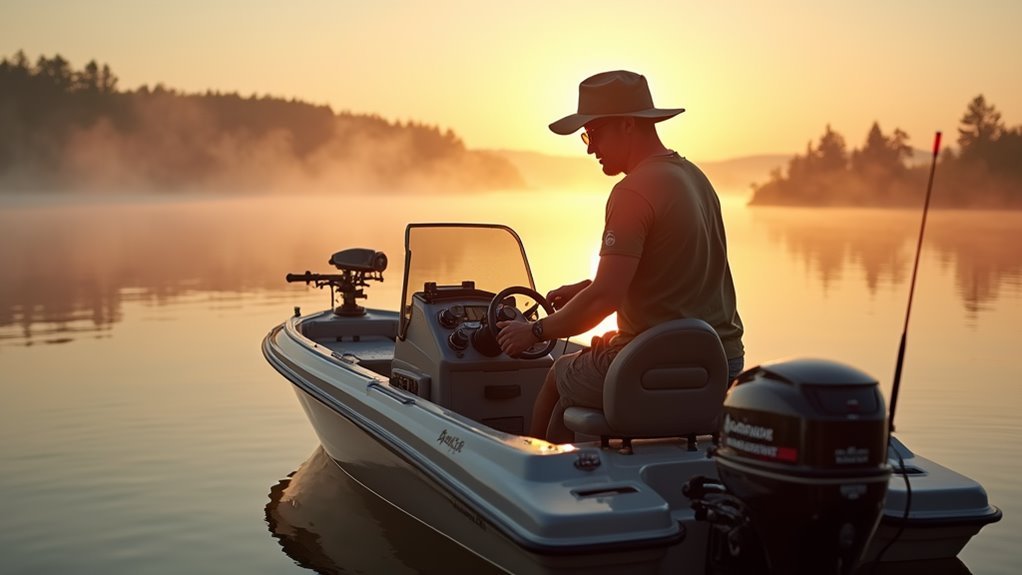
Utilizing our trolling motor to its full potential requires embracing a few best practices, particularly with modern features like Spot-Lock. It's vital we comprehend how Spot-Lock can not only enhance our fishing experience but also preserve the environment.
Remember, respecting nature is key to sustainable fishing adventures. Maximizing these features involves proper user training, empowering us to effectively use the high-tech tools at our disposal. Using trolling motors equipped with anchor-lock technology allows for locking the position without the need for conventional anchoring, which is especially useful in areas with snag-infested or soft bottoms.
Let's explore some best practices:
- Refine Positioning: Use the jog functionality to adjust the boat's position against wind and currents for the most precision.
- Noise Awareness: Engage Spot-Lock only after the motor stops to reduce noise, keeping fish undisturbed.
- Environmental Care: Avoid using Spot-Lock near bridges or large structures that could interfere with satellite connection.
- Battery Management: Verify batteries are fully charged to maintain reliable performance and avoid any interruptions during your trip.
Troubleshooting Common Issues
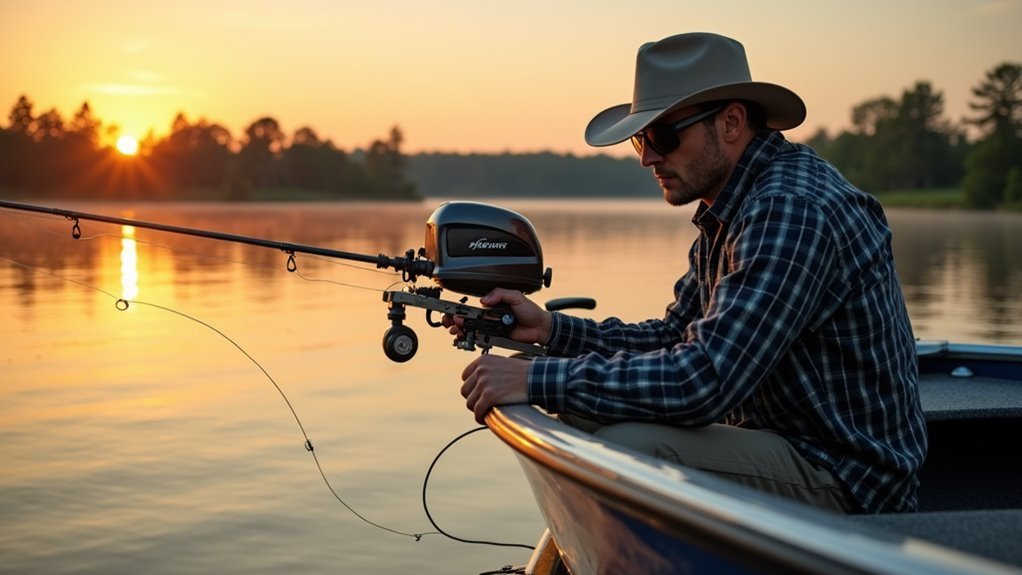
After embracing the best practices for using our trolling motor, we may still face occasional challenges with modern features like Spot-Lock. Spot-Lock issues can often stem from connection checks or calibration errors. Let's dig deeper into some practical diagnostic steps.
First, examining the foot pedal can reveal loose or corroded connections. Remove the bottom plate to check the wires and plugs. Clean the button contacts and guarantee the lever screw is tight. Also, a dirty film on the magnet may cause issues with the button's operation, so thorough cleaning is advised. Also, consider potential calibration errors impacting Spot-Lock's performance. Incorrect setup can cause the trolling motor to malfunction, so pay attention to these details.
In this table, we summarize common issues:
| Problem | Possible Cause | Solution |
|---|---|---|
| Malfunctioning Spot-Lock | Loose/Corroded Connections | Inspect and clean connections |
| Spot-Lock Button Issues | Debris Interference/Magnet Missing | Clean contacts/check magnet |
| Poor Spot-Lock Performance | Calibration Errors | Recalibrate GPS and motor |
Examining the GPS puck's Bluetooth connection is another crucial step. Connection issues sometimes play havoc on performance, leading us to double-check these components. If problems persist, contacting an authorized service center may be the next step. Address the technical challenges head-on, knowing freedom on the water awaits with successful troubleshooting.
Tips for Enhancing Performance
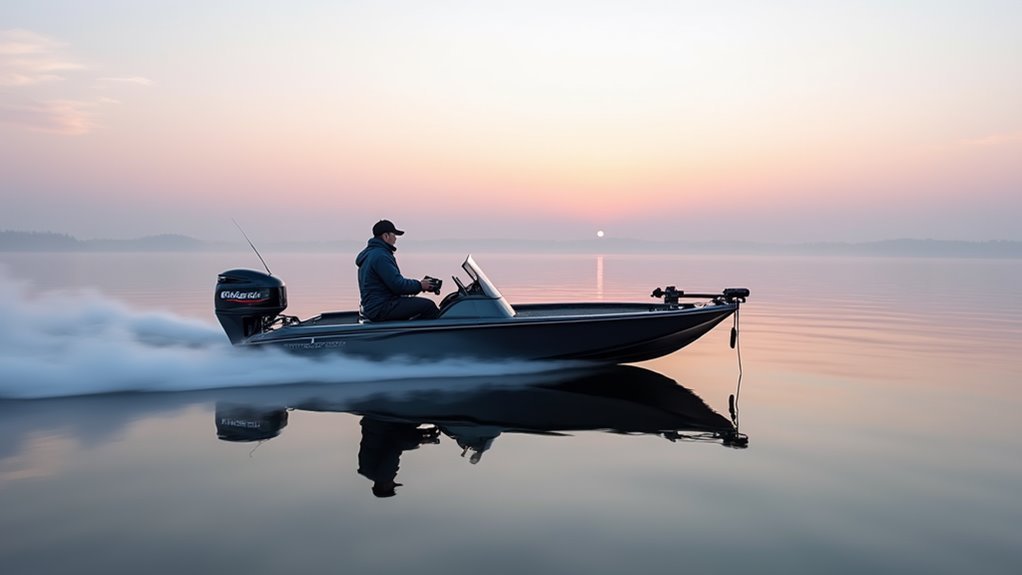
To get the most out of your trolling motor's performance, focusing on key enhancements is essential. By doing so, we can navigate the waters with ease and precision, embracing the freedom that our motor offers. Think of it as tuning a fine instrument, where simple adjustments can lead to remarkable improvements.
First off, Battery Maintenance is vital. Ensuring our batteries have the right amperage and amp-hour ratings keeps the motor running smoothly for longer periods. Remember, motors with more than 80 lbs. of thrust require 3 x 12V batteries (36V total) for optimal efficiency.
- Regularly check and clean battery terminals to prevent corrosion.
- Store batteries in a cool, dry place to maintain their lifespan.
- Use a solar charger to keep them topped off without being tethered to an outlet.
- Implement parallel connections with additional batteries to extend runtime.
Next, let's not forget about Motor Calibration. Calibration guarantees our Spot-Lock and Anchor Lock features work as intended, holding our position steady even against challenging winds and currents.
We should follow the manufacturer's instructions to calibrate the motor regularly, especially after transporting the boat.
With these tips in mind, we're set for seamless adventures, ready to explore new fishing spots and enjoy the tranquility of the open water.
Frequently Asked Questions
How Do Weather Conditions Affect Spot-Lock and Anchor Lock Performance?
When we're out in heavy winds and strong currents, Spot-Lock and Anchor Lock performance can suffer due to battery strain and difficulties maintaining position. Prioritizing wind resistance and accounting for current strength help maximize our freedom on the water.
Can Spot-Lock and Anchor Lock Be Used in Saltwater Environments?
We can confidently use Spot-Lock and Anchor Lock in saltwater environments. Advanced coatings combat saltwater corrosion, while clever tech negates marine life interference. Let's embrace the freedom to explore vast oceans with stability and precision.
What Impact Does Shallow Water Have on Lock Features?
We've all faced the rebellious force of shallow waters, where lock features flounder in minimal depths and tricky bottom compositions. Spot-Lock dances clumsily, spooking fish, reminding us that sometimes, nature won't be tamed by technology.
How Do I Maintain Accurate GPS Functionality With My Trolling Motor?
Let's guarantee our GPS functionality stays accurate by prioritizing GPS calibration and ideal antenna placement. Proper setup lets us enjoy unrestricted adventures on open waters, adapting seamlessly to the elements while maintaining precise control and freedom.
Are There Specific Trolling Motor Brands Better Suited for Lock Features?
Imagine we're out fishing in choppy waters; Minn Kota excels with its high precision lock accuracy. Choosing the right brand involves brand comparison and feature customization, ensuring we get the freedom to fish comfortably and confidently.
Conclusion
As we explore the benefits of Spot-Lock and Anchor Lock, it's amazing to think that these advanced trolling motors can keep us within a 5-foot circle, even in challenging conditions. Pretty cool, right? They give us the freedom to focus on fishing without constantly adjusting the boat. By understanding setup and maintenance, we can enjoy smooth, hassle-free trips. So let's embrace this technology together, make the most of our time on the water, and reel in more fish!